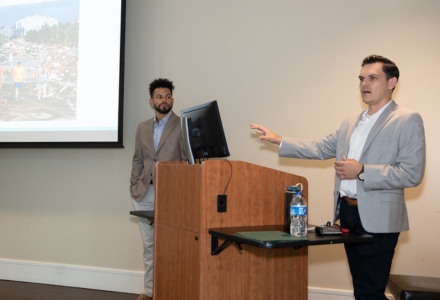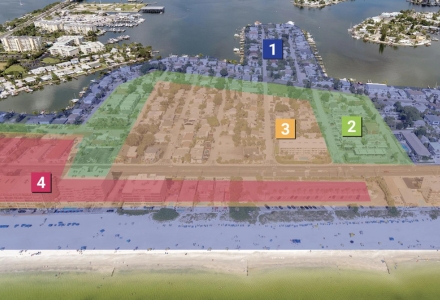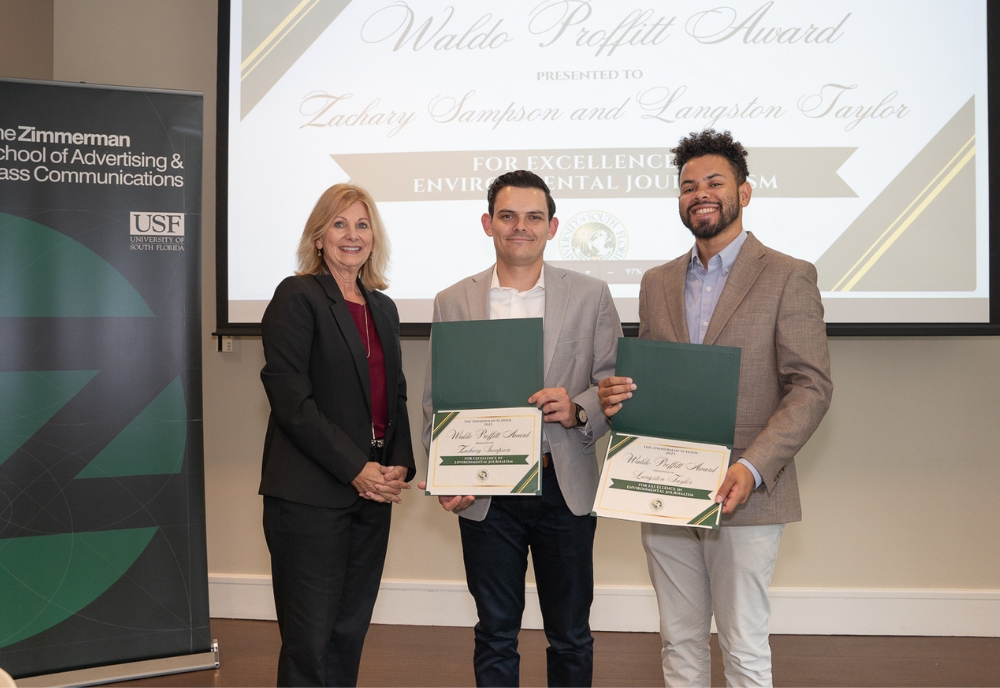The Zimmerman School of Advertising & Mass Communications at the University of South Florida named Tampa Bay Times journalists Zachary Sampson and Langston Taylor as recipients of the Waldo Proffitt Award for Excellence in Environmental Journalism in Florida.

Tampa Bay Times journalists Zachary Sampson (right) and Langston Taylor (left) share more information about their “Rising Threat” series. (Photo by Alessandra Casanova)
Established in 1998 by friends of Waldo Proffitt, a former editor of the Sarasota Herald-Tribune, the $1,000 award recognizes distinguished examples of reporting about environmental issues in Florida.
The award, which is celebrating its 25th year, is made possible by the Waldo Proffitt Scholarship Fund of the Community Foundation of Sarasota County, Inc. and is awarded to a journalist, or team of professional journalists, for their outstanding achievement in a story or series of stories, commentary, or editorials.
“The Tampa Bay Times really prioritizes and values environmental reporting. I think it’s something for our readers that they care a lot about and that they need to understand. It’s really a privilege and an honor to see that work recognized,” Sampson said.
Sampson, a former environmental reporter who is now an investigative reporter for the Times, was also recognized last year for his work on the environmental consequences of the discharge of toxic wastewater from Piney Point, a former phosphate mining operation in Manatee County.
Taylor currently serves as a data editor and works with reporters and editors to present data in easy-to-digest ways for readers.
“This year we honor Zach and Langston, and their editor from the Times, for their engaging in-depth reporting on the increased flood risks that rising sea level brings to our already vulnerable Tampa Bay area,” Whitt said in her opening remarks during the award ceremony held on the USF campus in November.
Their work, Rising Threat, is a multipart and multimedia series that includes video and interactive elements.
“This is an example of public service journalism, which reflects a first-of-its-kind partnership with the National Hurricane Center that utilizes maps, data, public records, and computer models to help residents understand that the risk they seemingly already underestimate is getting much worse,” Whitt said.
The four-part series originated with an investigation on the danger and risks Tampa Bay faces post-hurricane.
The pair shared that the series began while reporting on 2018’s Hurricane Michael in Mexico Beach, Fla.
“[Mexico Beach] was completely devastated and a lot of the damage, even though it was a Category 5 storm with heavy winds, was caused by flooding,” Sampson said. “While we covered the immediate aftermath, we kept going back to Mexico Beach, a little town of only 2,000 people, to try to figure out why were they so caught off guard? What are the lessons that we can draw from this little town for the rest of Florida?”
“One thing we heard from a lot of folks there is that they did not think they were at risk of flooding because they were not in a flood zone,” Sampson explained. “We started asking questions about that. Why is that the case? What we learned is that there is a real gap in the public's knowledge about flood risk and it's getting worse because of sea level rise. The floods are going to change. That is where this story started.”
Sampson and Taylor spoke to more than 100 people, including residents, professors, forecasters, insurance experts, scientists, lawyers, and government officials. They also worked with researchers at the National Hurricane Center, University of North Carolina, Virginia Tech, Massachusetts Institute of Technology, and Princeton to model storm surge under current conditions and with the potential sea level rise.
“Tampa Bay's risk really lies because of how we're set up for flooding. Category 1, Category 2, can really damage us, and they're made worse by the fact that people underestimate them. That is what separates Tampa Bay from other places,” Sampson said.
The reporters explained that the shallow geographic structure of the Gulf of Mexico puts Tampa in a precarious position for destructive flooding.
They also shared that not only was gathering the data vital for this series but presenting it in a way that the public could understand was key as well.

Graphic analysis created for the series illustrating an example of flooding in areas of Tampa Bay based on hurricane category levels using information from the National Hurricane Center. (Source: Tampa Bay Times)
“Working with public officials is how this project became possible,” Sampson said.
“When you go into news, you have a really big advantage because you have a built-in audience and you have editors and other journalists that are working to make things clear to the average person,” Taylor said. “But, if you’re really into coding and advanced data analysis, there’s a place for that in news. It’s very, very valuable and it is one of the only areas in news that is still growing.”
Taylor also stressed that design elements are vital in data journalism.
“It’s just hard to read 100,000 words,” Taylor said. “You need to have people entertained throughout.”
“It means a lot to be considered for something like this,” Taylor said. “We don’t do work like this unless we feel that it matters to people. Both Zach and I live in Tampa Bay, and we feel that Florida’s safety when it comes to flooding risks is going to be an issue for our lifetime. We recognize that it sometimes takes awards and public recognition for other people to care about things, but we just hope everyone reads this story.”
Read the full Rising Threat story series.
